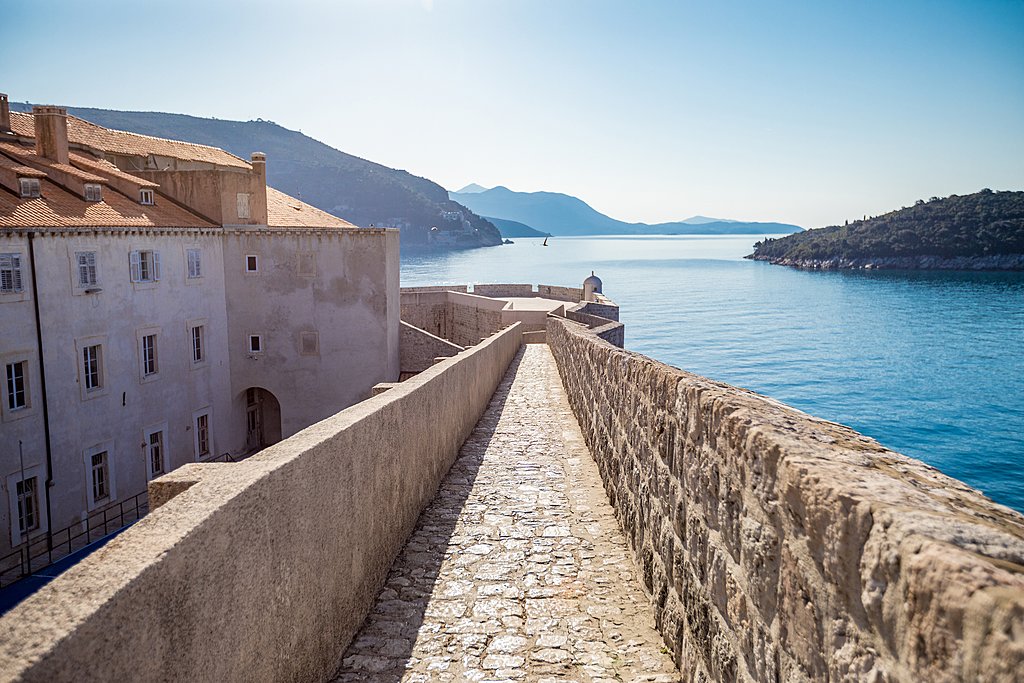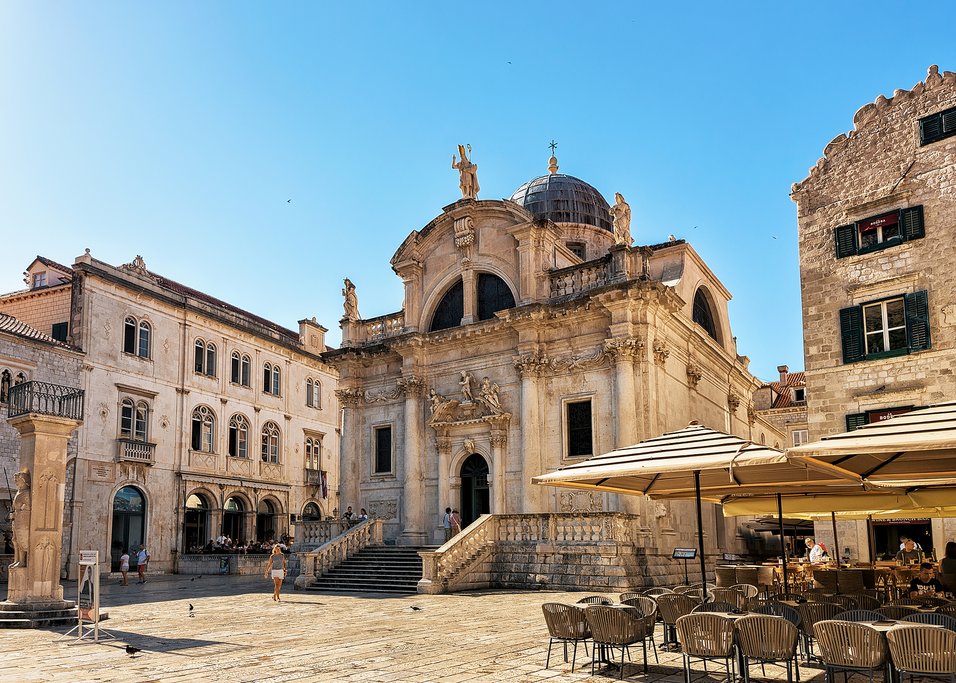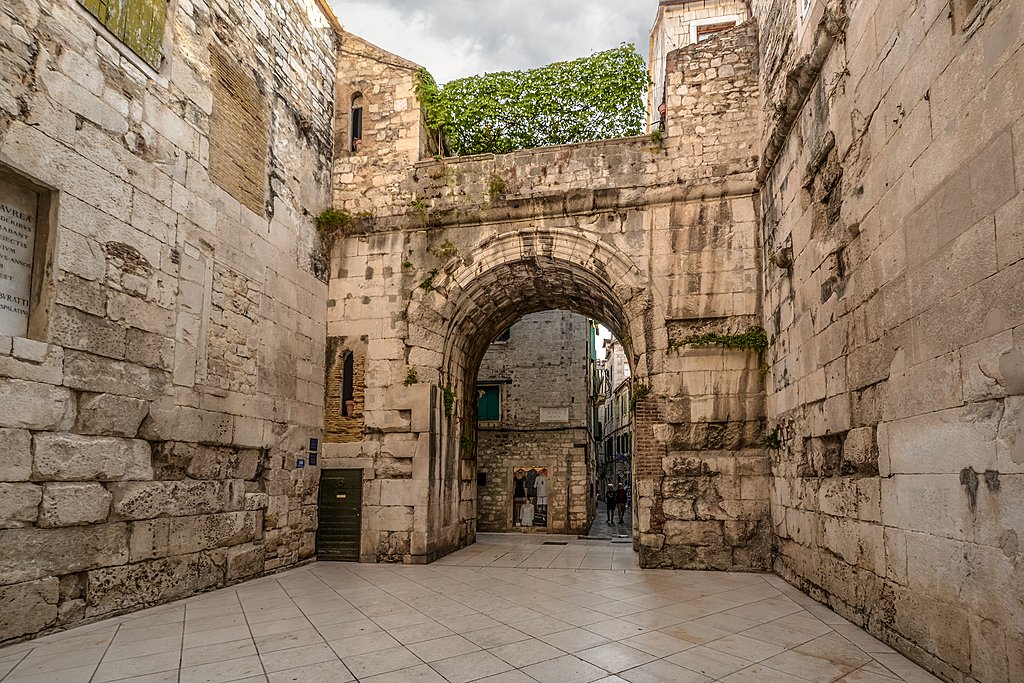Highlights
- Take a scenic hike or kayak around the car-less island of Koločep
- Ride a bike through the unspoiled and lush landscapes of Mljet's national park
- Enjoy a day of sailing to Šolta Island
- Swim in the emerald-green lagoon of Krka National Park's Skradinski Buk waterfalls
- Navigate the maze of narrow stone streets on the eclectic island-city of Trogir
Brief Itinerary
| Day | Highlights | Overnight |
|---|---|---|
| Day 1 | Welcome to Dubrovnik! | Dubrovnik |
| Day 2 | Walking Tour of Dubrovnik | Dubrovnik |
| Day 3 | Day Trip to the Island of Koločep | Dubrovnik |
| Day 4 | Explore Pelješac Peninsula and Korčula | Ston |
| Day 5 | Visit Mljet National Park (Day Trip from Ston) | Ston |
| Day 6 | Ston to Split, Walking Tour of Split | Split |
| Day 7 | Sail & Swim around Šolta Island | Split |
| Day 8 | Visit Krka National Park & Šibenik (Day Trip from Split) | Split |
| Day 9 | Explore Trogir, Klis, & Solin (Day Trip from Split) | Split |
| Day 10 | Depart Split |
Detailed Itinerary
Day 1: Welcome to Dubrovnik!

This is a treat because you'll be arriving in one of the most ancient fortress cities in Europe. Known as the "Adriatic Pearl," Dubrovnik is a piece of history. While there's evidence of settlements as far back as the Byzantine era, this area only came into its own in the 12th and 13th centuries when it was under the rule of the Venetians. Throughout the middle ages, it was a fortress port encircled by stone walls and filled with baroque churches and renaissance/gothic palaces that still stand today.
Upon arrival at the airport, you'll transfer to your hotel for check-in. Despite being tired from the journey, you'll likely want to get out and explore. Can't-miss activities include riding the cable car up to Srđ Mountain to take in the sunset over the nearby Elafiti Islands, visiting Lovrijenac and Bokar fortresses, and walking along the smooth, limestone-paved streets of historic Old Town.
After spending some time getting to know the city, duck into one of Dubrovnik's many wine bars to relax. It's a good plan, as there's no better manner in which to celebrate your first day in Croatia than by enjoying a glass of white or red wine as the sun goes down over Dubrovnik's Old Town. For dinner, there are a number of great restaurants you can choose from.
Day 2: Walking Tour of Dubrovnik

Start your day early (around 8 am) to avoid the crowds and to embark on a tour of Dubrovnik where you'll meet your expert guide outside the entrance to the medieval city at the 16th-century Pile Gate. Entering Old Town, you'll uncover centuries of the city's rich history as you listen to stories of local life and legends and of the importance Dubrovnik once held in the era of the Republic. Highlights include Onofrio's Fountain, the 15th century Rector's Palace, Luza Square, the Church of St. Blaise (St. Vlaho), and the café-lined streets of Brsalje Street.
After touring the streets and alleys, you'll head for Lovrijenac Fortress as well as the city's impressive defensive walls, the second-largest set of city walls in the world. At certain places the wall rises 75 feet high, offering excellent vantage points for photos of the coastline.
For the rest of the afternoon, explore Dubrovnik and its surroundings on your own or enjoy the afternoon sun on the nearby beaches. Come early evening, you can get stunning panoramic views over the city and Adriatic by taking the cable car up to Srđ Mountain before descending back down for dinner at one of Dubrovnik's great restaurants.
Day 3: Day Trip to the Island of Koločep

Today, you'll visit one of the most beautiful islands in the Elafiti archipelago. Koločep (referred to by locals as "Kalamota") is the southernmost inhabited island in Croatia, is a little over a square mile, and is home to just over 150 year-round residents, mostly living in Gornje Čelo and Donje Čelo. Two miles (3 km) of paths connect the two hamlets with additional paths and walkways connecting the rest of the island through dense vegetation. There are no cars on Koločep adding to its relaxed atmosphere.
Though a popular day trip from Dubrovnik, the island maintains a somber feel. Visit Donje Čelo to admire its cluster of stone houses before relaxing on one of Croatia's rare sandy beaches. A little way uphill you can take a concrete path that cuts inland to Gornje Čelo. From there, explore the many paths crisscrossing through pine and deciduous forest that open up to beautiful views of the Adriatic.
There's also the option to take a scenic hike or even go sea kayaking around the island. The latter is highly enjoyable due to the number of beaches, coves, and hidden coastal caves to explore. As an added bonus, there's a great little family-run restaurant on Koločep that serves the best grilled calamari in Croatia.
Ferry time (Dubrovnik to Koločep): 30 minutes
Day 4: Explore Pelješac Peninsula and Korčula

Take the day to explore the rugged Pelješac peninsula and, if time allows, visit the Old Venetian-style town of Korčula.
The Pelješac peninsula—known for its rugged scenery, robust red wines, and tasty oysters—is a spit of land that stretches for 40 miles (65 km) west of the mainland. Pelješac is home to a number of small towns and villages: Orebić, connecting Pelješac to Korčula, and twin settlements, Ston and Mali Ston, sit opposite each other at the isthmus of the peninsula. You can rent a car in Dubrovnik and explore the peninsula and Korčula on your own or hire a driver for a guided tour.
Stop in Ston to explore one of the longest defensive stone walls in Europe (originally built to keep predators away from the town's saltpans) and discover the importance this area held in the 14th century. Enjoy a light meal of locally-grown fresh oysters and mussels after you climb part of the parapet walkway of Ston's wall for beautiful views over the town and its glittering saltpans—one of the oldest and still active in the Mediterranean!
Continue on your way to Orebić, stopping to sample Dingač, Croatia's most well-known red, and other varietals at any of the numerous vineyards populating the area. Should you choose, you can take a tour of one of the area's family-run wineries for a further sampling of Dingač's famous reds. Once in Orebić, you might like to wander its narrow streets, noting the charming stone villas once occupied by famous sea captains. And if there's time, board a quick ferry to Korčula where you'll have the afternoon to discover Korčula's numerous restaurants, taverns, shops, and bars as you roam the maze of gray stone houses, alleys, churches, and squares.
When you're ready, make the return journey back to Ston and to your hotel.
Driving time (Dubrovnik to Ston): 1 hour
Driving time (Ston to Orebić): 1 hour
Ferry time (Orebić to Korčula): 20 minutes
Chat with a local specialist who can help organize your trip.
Day 5: Visit Mljet National Park (Day Trip from Ston)

Today you'll board a ferry from Trstenik to Polače on Mljet Island where you'll disembark to spend time exploring Mljet National Park. Considered the greenest as well as one of the larger Adriatic islands off the Croatian coast, Mljet is a thin strip of land parallel to the Pelješac peninsula and runs 20 miles (32 km) long and up to 2 miles (3 km) wide. The park itself covers a third of the island and is made up of lakes and bays, dense forests, and olive groves.
Rent a bike to explore the unspoiled western side of the island in the National Park and stop to enjoy a unique swim in any of the beautiful lush coves. Popular sights worth a visit include Veliko and Malo Jezero (Large and Small Lake)—two salt lakes in the park, connected by a narrow canal, Soline Bay, and a sea-belt some 500 miles wide off the most prominent cape, the Cape of Mljet. If the mood should strike, stop for a swim in the lakes (which are invariably warmer than the open Adriatic sea!). There's also the option to join a guided tour through the park to visit a 12th-century Benedictine monastery.
Grap lunch at a local restaurant before making your way back to your hotel in Ston.
Day 6: Ston to Split, Walking Tour of Split

In the morning, you'll drive northwest from Ston to Split to check into your accommodation before setting out to explore your surroundings on a walking tour. An ancient coastal city founded 1,700 years ago by Roman Emperor Diocletian, Split's Old Town includes a number of impressive sites, including Peristyle, Cathedral of St. Dominus, the Piazza, and Diocletian's Palace, one of the best-preserved Roman buildings in the world.
Depending on a time that suits you, you'll meet your local guide for a private tour of Split's popular attractions, where you'll start in Peristyle Square, taking in the 3,500-year-old sphinxes Diocletian brought back from Egypt before exploring the 4th-century Diocletian's Palace. Other noteworthy attractions include the Iron Gate, Pjaca Square, and the 15th-century Town Hall.
In the evening, take a stroll along Split's seafront Riva to admire the waterfront views before finding the off-beat Konoba Dioklecijan restaurant, just to the left of the Bronze Gate for a bite to eat, its outdoor terrace built into the walls of Diocletian's Palace.
Driving time: 2.5-3.5 hours
Day 7: Sail & Swim around Šolta Island

Today you will spend a full day enjoying the sun and sea on a sailing boat with time left over to explore Šolta Island. Head to the Split marina to meet your captain and crew, before departing for Šolta, your speed and route determined by weather conditions.
You'll stop for swimming breaks, taking advantage of the many beaches and pristine coves this sleepy island has on offer. Once on Šolta, you'll have the chance to explore the small town of Stomorska as well as have lunch in one of its local restaurants. Though Šolta is so close to Split, it is far from modern life, further adding to its understated charm.
You'll return to Split in the late afternoon.
Day 8: Visit Krka National Park & Šibenik (Day Trip from Split)

Krka National Park is just over an hour's drive away from Split and is a nice place to visit in the morning before the crowds arrive. With seven waterfalls—the largest and most impressive being Skradinski Buk—Krka National Park is one of Croatia's top-rated parks home to a network of striking waterfalls. The Krka River, another highlight of the park, carves through the limestone and creates a spectacular canyon on its 44-mile journey (70 km) from the foothills of the Dinaric Alps to Šibenik.
Follow the winding wooden paths that traverse emerald pools and river islands to prime lookout spots in which to view the falls where you'll also be able to take a dip in one of the lagoons as Krka is the only national park in Croatia where swimming is allowed. Mother Nature saved the best for last with Skradinski Buk. Cascading 78 feet (24 m) down into an emerald lagoon wider than the falls are tall, you'll find restaurants, snack stands, and ice cream shops at the base of this picture-perfect locale to satisfy any food-related cravings.
After spending the morning in Krka, head to the coastal town of Šibenik for the afternoon. A true Croatian town founded by the Croat king Petar Krešimir IV in the 11th century, Šibenik is home to impressive fortresses, music festivals, and medieval gardens. Start with a visit to the famous UNESCO-protected St. James' Cathedral, before selecting a restaurant for your dinner—perhaps Pelegrini, a Michelin Star restaurant and wine bar just above the cathedral.
Driving time (Split to Krka): 1-1.5 hours
Driving time (Krka to Šibenik): 20 minutes
Driving time (Šibenik to Split): 1.5 hours
Day 9: Explore Trogir, Klis, & Solin (Day Trip from Split)

For lovers of history and archaeology, there is a wealth of medieval and Roman history to be found in the immediate surrounds of Split.
Thirty minutes up the coast, located on a small island, a stepping stone between the mainland and the much larger Čiovo, is the ancient coastal city of Trogir. Rich in medieval, Renaissance, baroque, and Romanesque architecture, you will have time to navigate the narrow stone streets, every five minutes of walking taking you to the island's edge. Explore the historic core, starting with the Garagnin-Fanfogna Palace, working your way to the Cathedral of St. Lawrence to admire Radovan's 13th-century Romanesque portal and the bizarre creatures around the doorposts.
Stroll along the Riva, finding your way to the 15th-century Kamerlengo Fortress for a great panoramic view over the island. and don't be surprised if you're serenaded by traditional acapella groups called klapa, along your way.
On your return back to Split, consider a short detour to visit the impressive medieval Klis Fortress. The more than 2000-year-old fortress is perched on top of an isolated rocky eminence and overlooks Split as well as the ancient Roman settlement of Salona (now Solin)—the original capital of the Roman province of Dalmatae and one of the five largest cities in the entire Roman empire. Wander the large Roman amphitheater where early Christians were fed to lions—fit for a city of 60,000 in its peak. Salona is remarkably little visited by tourism which makes it an unsung gem for those wanting a more personal yet fascinating Roman experience.
Driving time (Split to Trogir): 1 hour
Driving time (Trogir to Solin/Klis): 30-45 minutes
Driving time (Solin to Split): 20 minutes
Day 10: Depart Split

If you have a free morning before departing, check out the Green Market (Pazar Market). A lively fruit and vegetable outdoor market just east of the Diocletian Palace, this is a great place to see how the locals shop and to pick up some fruit for your flight home. Farmers from the surrounding areas of Split come into town every day to sell their seasonal local produce from sunrise to 2 pm.
Depending on traffic, it usually takes 45 minutes to travel from Old Town to the airport. Best to arrive at the airport at least two hours prior to your international departure (and with some extra time to drop off your rental car, if you have one).


